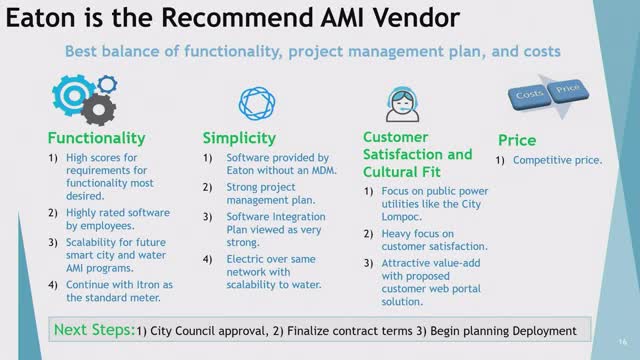Lompoc City Council considers Eaton's smart meter system for cost efficiency
May 07, 2025 | Lompoc, Santa Barbara County, California
Thanks to Scribe from Workplace AI and Family Portal , all articles about California are free for you to enjoy throughout 2025!

This article was created by AI using a video recording of the meeting. It summarizes the key points discussed, but for full details and context, please refer to the video of the full meeting. Link to Full Meeting
Eaton was selected due to its proven track record with similar-sized cities, competitive pricing, and strong references. The proposed system is designed to be user-friendly and easy to maintain, addressing the city's current challenges with aging technology. The existing meters, which are over a decade old, have a failure rate of approximately 3%, leading to increased operational costs and inefficiencies.

Before you scroll further...
Get access to the words and decisions of your elected officials for free!
Subscribe for FreeThe deployment of the new AMI system is expected to take about three years, with costs spread over this period. The most significant expenses will come from the meters and modules, while software costs will be comparatively lower. The city plans to vote on the contract in the upcoming May meeting, with funding sourced from the electric fund as part of the city’s Capital Improvement Projects (CIPs).
Council members raised concerns about the financial implications for residents, particularly regarding how the costs would affect monthly electric bills. Current average bills range from $30 to $40, and while the new system aims to provide long-term savings, the upfront investment will be borne by ratepayers. The council emphasized the importance of transparency and thorough discussion, noting that the utility commission had not been involved in the initial decision-making process.
In addition to improving operational efficiency, the new technology will allow for remote meter readings and better management of power quality, which could lead to further enhancements in service delivery. The council is committed to ensuring that the transition to this modern infrastructure aligns with the community's needs and expectations, aiming for a balance between technological advancement and fiscal responsibility.
As the city prepares for the vote, residents are encouraged to stay informed about the developments and consider how these changes may impact their utility services in the future.
Converted from Lompoc City Council 5 6 2025 meeting on May 07, 2025
Link to Full Meeting
Comments
View full meeting
This article is based on a recent meeting—watch the full video and explore the complete transcript for deeper insights into the discussion.
View full meeting




